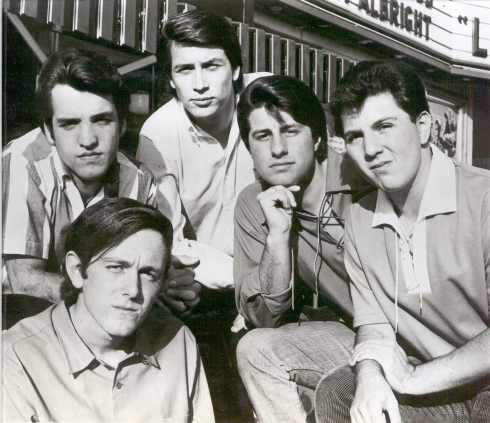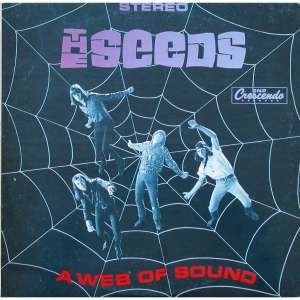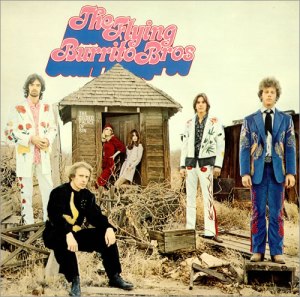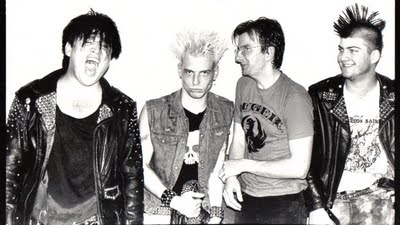I read the LA Weekly’s Top 20 Greatest L.A. Punk Albums of All Time: The Complete List and realized that their list was missing some of my favorites, so I decided to make my own list. I’m attempting to be a bit ambitious though and include a few other genres as well as a history leading up to my own favorite LA punk albums, singles & videos. This is by no means a “complete list,” but please note that I do not claim to be making a complete list as the LA Weekly has done.
Los Angeles’ back story. The Tongva and Chumash Indians were here first, followed by the Spaniards and Mexican rancheros. In 1781 forty settlers (two-thirds of which were mestizo – of mixed race) founded what would become the City of Los Angeles. L.A. was the capital of Mexico’s Alta California province until the US won the Mexican-American war in 1847. White European-American settlers didn’t come en masse until the late 1800s when the east-west railroad system was constructed by Chinese migrant workers. William Mulholland found a way to divert river water that irrigated inland apple orchards into LA by constructing one of the largest water canals in US history in 1913 – also marginalizing a number of inland farmers and their livelihood. The water supply allowed Los Angeles to boom from the 1880s-the 1920s.
The romance of moving to California was furthered by a very popular 1884 novel “Ramona” which depicted LA as a veritable garden of Eden with a mixed race populous living harmoniously. Of course, this was far from the truth as the influx of white Americans slighted those who were there before (Indigenous and Chicanos), and began to oppress those who built their mode of transportation to arrive there in the first place, the migrant worker Chinese. It’s a very American story, but distinctly noir-ish as Hollywood films would later convey.
Southern California was an ideal climate and location to shoot films because of the temperate year-round climate and close proximity to a variety of scenic film locations – the beach, mountains and desert. This fact as well as the romance of California brought the majority of the film industry to relocate from New York to LA. The 1920s was the prime of classic Hollywood, and bars and nightclubs popped up all around the Sunset Strip. Jazz Music was in as well as other popular music of the time.
During prohibition, the Italian-American Los Angeles Crime Family controlled bootlegging in conjunction with the corrupt LAPD. Clandestine tunnels were built underneath downtown LA, ferrying booze between speakeasys and bars like The King Eddy and Cole’s.
In the 1930s, like the rest of the nation, LA suffered during the Great Depression. “Day of The Locust” (1939) by Nathanael West depicted Hollywood during the depression (out of work carnies and dwarves, alcoholic actors, damaged women etc.). John Fante’s “Ask The Dust” (1939) showed what life was like for a struggling young downtown LA transplant in the 30s. “Okies,” migrant laborers from Oklahoma’s dust bowl, were the next group to be marginalized, as Steinbeck documented in his great work of fiction “Grapes of Wrath” (1939). In the early 30s, despite LA being racially diverse, chalk full of Latinos, Filipinos, Chinese, Italians, a policy of “Mexican Repatriation” was enforced, with 12,000 Mexican-Americans sent back to Mexico. However, by the end of the 30s there was still a very strong Chicano presence, with about 3 million Latinos in LA.
During WWII, Japanese-Americans were sent to internment camps and tension began to build between “pachucos” or “zoot suiters” and white Marines and Sailors stationed in LA. When a fight broke out between zoot suiters and white military men, the LAPD swarmed in along with the military and beat any Latino or Filipino or Black seen wearing a “Zoot Suit.”
Lalo Guerrero is known as the “father of Chicano Music” in LA during the 1940s and personifies the tough, rebellious and suave Zoot Suiter vibe of the 1940s with songs like “Marihuana Boogie” and “Los Chucos Suaves.”
During the post-war 1940s a large influx of blacks from the South came into LA and were able to create farms and later a thriving middle-class black population in South LA due to the abundant factory work at the Goodyear, Boeing, McDonnell Douglas and Firestone factories among others. They brought with them a rich musical tradition of blues and jazz.
MY FAVORITE LA RECORDS
Okay, let’s get going. Some of these are rather obvious selections, but there are certain classics that can’t be ignored. As I dug into this history, I remembered that I love the music too. Please let me know if I’m excluding any great LA records or singles.
RITCHIE VALENS s/t LP (1959)
Does Ritchie Valens not make you want to cry? He makes me want to cry. I adore his music. Ritchie was a Mexican-American from Pacoima in the San Fernando valley, raised by a single mother. He also had a noogoodnik brother named Bob (played brilliantly by Esai Morales in the excellent 1987 biopic “La Bamba”). Ritchie Valens is what the rags-to-riches westcoast American dream was in the 1950s. He was talented and humble and died young in a 1959 plane crash along with Buddy Holly and the Big Bopper (“The day the music died”). Long live Ritchie Valens.
RITCHIE LP (1959)
RICHIE VALENS “In Concert At Pacoima Jr. High” (1961)
Buddy Holly’s guitarist Tommy Allsup lost the coin toss with Ritchie Valens in Clear Lake, Iowa, securing Ritchie a place on the doomed propeller plane
JAN AND DEAN “SURF CITY” (1963)
Jan and Dean were the epitome of All-American, Apple Pie eating California white boys. Brian Wilson penned their 1963 hit “Surf City.” “Two Girls For Every Boy…” who wouldn’t want two girls? Who wouldn’t want to go to surf city and have some fun where the girls are two to one? On On April 12, 1966, William Jan Berry suffered a fatal car crash on Whittier Drive, nearby “Dead Man’s Curve.” Eerily, two years earlier they released a hit song about that very stretch of Sunset Blvd. near UCLA.
BUCK OWENS “LOVE’S GONNA LIVE HERE” (1963)
Buck Owens formed his band up in Bakersfield but I’m including him in this LA list because he recorded nearly all of his albums and hit singles in the basement studios of Capitol Records in Hollywood. His upbeat and twangy country sound made it across the Atlantic and the Beatles would cover his hit “Act Naturally” (1963) on their Help album in 1965. Buck Owens music would influence scores of LA musicians to follow. His bar and restaurant “Crystal Palace,” is the only remaining honky tonk in Bakersfield today.
THE BEACH BOYS “SURFER GIRL” (1963)
The Beach Boys were from the sleepy South Bay town of Hawthorne. They’re one of the most recognizable purveyors of the Southern California sound. While the harmonies often sound happy and upbeat with tunes like “Fun Fun Fun,” songwriter Brian Wilson often suffered from deep depression and struggled with drugs and alcohol. “Pet Sounds” released in 1966 seems like the obvious choice for the Beach Boys best album, but I’m going with 1963’s “Surfer Girl” LP on Capitol Records. There’s something about the lament, sadness and longing with the slower songs on this Beach Boys release that always tugged at my heartstrings. Their finest moment is “In My Room,” a song that I listened to dozens of times in my room as a teenager on cassette tape. Every time I hear it I feel it.
THE SUNRAYS “I LIVE FOR THE SUN” (1965)
The Sunrays were initially formed as “The Renegades” in the late 50s. They hailed from the affluent ‘burb of Pacific Palisades, bordering Santa Monica and the Beach. They only released 1 LP (Andrea, 1966), but their hit was, “I Live For The Sun.” What else would a surfer teenager from the 60s have to live for? Sun, cars and girls. That’s what we’re trying to sell you. That’s what California is all about.
THE BYRDS “TURN TURN TURN” (1965)
Was there another album in the mid 60s besides Bob Dylan that encapsulated the vibe of the 60s more than the Byrds “Turn Turn Turn” LP in 1965? I think not. However, my favorite Byrds LP is “Sweetheart Of The Rodeo” from 1968. They decided to bring in Southern boy and recent LA transplant Gram Parsons, who convinced them to record a country album in Nashville. An LA band recording a country album? Unheard of. It not only sounds authentic and heartfelt, it sounds fantastic and would usher in a new era of LA country rock led by folks like Jackson Browne and The Eagles. As far as THE LA country-rock albums before the schlocky glossed over Eagles: The Byrds “Sweetheart of the Rodeo” and Flying Burrito Bros “Gilded Palace of Sin,” to come up shortly.
THE BYRDS “SWEETHEART OF THE RODEO” (1968)
Gram Parsons vocals on the Byrds 6th album, “Sweetheart Of the Rodeo” are nothing short of brilliant:
CANNIBAL & THE HEADHUNTERS “LAND OF 1000 DANCES” (1965)
In the mid-60s there was a Sunset Strip/Hollywood scene led by bands like The Byrds, Love, Buffalo Springfield and The Doors and there was also something else going on in vibrant Chicano ‘hood of East LA. In East LA, bands like Cannibal & The Headhunters and Thee Midniters reigned supreme, but were often ignored by the Hollywood Scene. Cannibal & The Headhunters were the opening act on the Beatles 2nd US tour. Both Cannibal & Midniters would receive radio hits with their covers of the same song, “LAND OF 1000 DANCES,” later made even bigger by Wilson Pickett’s version (and R&B #1 hit) in 1966.
THEE MIDNITERS “WHITTIER BLVD” (1965)
Thee Midniters were known to be the “Beatles of East LA.” They were wildly popular and also had a hit with their cover of “Land of 1000 Dances,” as well as “Whittier Blvd,” the main drag in East LA. Also not ones to shy from being politically charged, they jumped on the wagon with Cesar Chavez and other Latino rights activists in the late 60s, recording “Chicano Power.”
THEE MIDNITERS “LAND OF 1000 DANCES”
THEE MIDNITERS “CHICANO POWER”
LOVE
Arthur Lee’s LOVE were probably LA’s greatest and most criminally underrated band. They played many nights of sold out residencies at Sunset Strip venues such as the Whiskey A Go Go. Arthur Lee was the undisputed king of the Sunset Strip during its prime in the mid-60s. His fashion sense, flair, drug use and eccentricity made him king, as he personified the vibe of LA in the 60s. Arthur Lee would later claim that Jimmy Hendrix ripped off his style. He also claimed that Jim Morrison idolized him and tried to emulate him, going as far as adopting the same breed of dog, dating his ex-girlfriend and getting signed to Love’s record label (Elektra). They were one of LA’s first rock bands that had both black and white members and they lived in a “castle” in Los Feliz.
Unfortunately due to Arthur Lee’s mental problems, they rarely toured outside of Los Angeles, not making it further than San Francisco. LA bands like the Byrds and The Doors would sell many more records and had much more national and international accolade. John Einarson’s “Forever Changes” does an excellent job at telling their tragic and beautiful story.
Love’s 1966 self titled LP (pictured above the book) is a perfect high energy romp of 60s garage punk. They notably covered Burt Bacharach’s “Little Red Book” with such attitude and flair that their version became a local radio hit.
LOVE’s 1967 album “Da Capo” is frenetic and bounces all over the place from rock to jazz to psychedelia. Arthur Lee claimed that the Rolling Stones stole “She’s A Rainbow” from his “She Comes In Colors” featured on this album. The hit however is “7 and 7 Is,” a proto punk classic that would later be covered by LA punk bands like The Weirdos.
LOVE’s 3rd album “Forever Changes” released in 1967, is pure bliss. The group would disband due to drug problems and Arthur Lee’s mental issues then reform with a completely different lineup. Love would never be the same. Before Arthur Lee’s death in 2006, he was able to reunite with original guitarist Johnny Echols and toured Europe with London’s philharmonic orchestra, playing “Forever Changes” from start to finish. A fitting finale for one of LA’s finest songwriters.
SEEDS
The Seeds first 2 LPs, both released in 1966, are unstoppable bare-bones raw garage punk. Frontman Sky Saxon was a madman. One of a kind. The Seeds were also instrumental in inspiring scores of punk bands in both the US and UK.
THE STANDELLS “DIRTY WATER” (1966)
The Standells were some more garage rock godfathers of punk from the fair city of Los Angeles. Coming from Italian and Chicano descent, these bad boys wanted to be The Beatles or the Stones of LA. Early in their career, they performed on “The Munsters” TV show playing the Beatles “I Want To Hold Your Hand.” They also appeared in the B-Movie “Riot on the Sunset Strip,” and played the title tune on the soundtrack. In the 80s, DC punk band Minor Threat would notably cover the Standells song “Sometimes Good Guys Don’t Wear White.” The Standells along with The Seeds exemplified the LA Sunset Strip bare-bones garage rock sound of the mid-60s.
THE STANDELLS
FLYING BURRITO BROS “GILDED PALACE OF SIN” (1969)
Gram Parsons and Chris Hillman quit the Byrds and formed Flying Burrito Brothers, a full on country group with some rock influences. This was before the Eagles, before Jackson Browne and before the “Country Rock” phenomena lead by The Eagles, Crosby Stills Nash & Young Etc. Gram Parsons was fully into drugs and fully into leaving town for months on end to tag along with Keith Richards and the Rolling Stones which would ultimately lead to his departure from the Burrito Bros. In their prime, Parsons and Hillman recorded “Gilded Palace Of Sin” in 1969, a fabulous record which never sold too many copies. The Rolling Stones gave “Wild Horses” to Gram and he recorded it with Flying Burrito Bros in 1971, one year before the Stones did. The Rolling Stones didn’t just give songs to anyone.
Gram Parsons would record 2 solo albums before his untimely death, OD’ing in Joshua Tree. His tour manager and Gram had made a pact, whoever died first would be cremated in Joshua Tree. Gram’s tour manager actually rented a hearse and stole his body from a LAX airport holding facility where it was due to be flown to Louisiana for a funeral there. Drunk out of his mind, he drove the stolen corpse of his dead friend out to the desert and doused Gram’s body in kerosene. The flame burst into a giant fireball, and park rangers and police saw the sky-high flame in the middle of Joshua Tree national park. Gram’s tour manager fled the scene and was later arrested but God bless him for following through with his promise and in the process creating one of the best rock and roll stories around. Long live Gram Parsons and his finest hour, “Gilded Palace of Sin.”
THE DOORS (1967)
Last and not least, this final selection will probably make many of my friends cringe and perhaps even squirm. I do not believe in guilty pleasures however. The Doors were and sounded like and embodied everything about Los Angeles. They were artistic, poetic, tortured, at times affected but at times REAL. Morrison was fucked up just like LA is fucked up. The guys together were everymen in the fact that they didn’t have to go into factories or work graveyard shifts to see what kind of feeling lay in the eyes of LA’s people. I challenge anyone to drive around Los Angeles and see the brown mountains and the foamy seashore and the traffic and the city and the cops and the homeless shopping cart people and the Mexican day laborers waiting for work in parking lots and the kids from the Midwest moving here in search of acting jobs and the drugs and the overdoses and the bars and nightclubs and stripclubs and stripmalls and car accidents ….. as you are taking this all in put on something by the Doors – as you’re driving in your car. And tell me the music doesn’t sound like everything you see… the vast spread-out city… the contradictions – the plastic surgery and red convertibles on the West Side to the roadside taco vendor on Whittier Blvd in East LA to the Skid Row dweller setting up his tent in a shut down storefront downtown… to the mentally ill guy on Hollywood Blvd, dressed like a superhero, trying to earn enough scratch to buy a hit of crack.
Tell me that the Doors doesn’t sound like all of this and I’ll tell you that you are wrong.
The Doors played in Ann Arbor, MI in the 60s and a young Iggy Pop was in the audience. The crowd was boo-ing Jim Morrison because the band refused to play their hit “Light My Fire.” Jim Morrison told the crowd to go fuck themselves. Iggy Pop loved this and would later say he had never heard a lead singer tell the crowd to fuck off or anything similar onstage. The Doors would inspire Iggy Pop to start his own confrontational rock n roll machine. Later when Iggy was strung out on drugs wandering around Los Angeles, keyboardist Ray Manzarek let Iggy crash at his house in the Hollywood Hills.
Manzarek would later prove instrumental in the career of LA punk band X, playing keys on their debut album “Los Angeles.” X would also cover the Doors’ “Soul Kitchen.”
The Doors were Los Angeles and Los Angeles was the Doors. What is Los Angeles now?
My favorite song to drive in LA to, whether I’m on the 101 Freeway or Sunset Boulevard or somewhere up in Highland Park or Eagle Rock or out in the San Gabriel Valley it’s always the same. “Riders On The Storm.” When it comes on the radio this moment happens, when I’m in my car with all of the traffic, hills and strip malls and LAPD squad cars. When this song comes on I begin to think clearly. I begin to know where I am.
THE DOORS LA WOMAN (1971)
The next installment of “My Favorite Los Angeles Records” will span from 1971-1981… Watts Stax to Jackson Browne to The Germs and maybe beyond. Stay tuned…
xo
Justin
PS If I missed anything or you want to punch me in the face via email, you can do so here: jmocheeks@yahoo.com










































